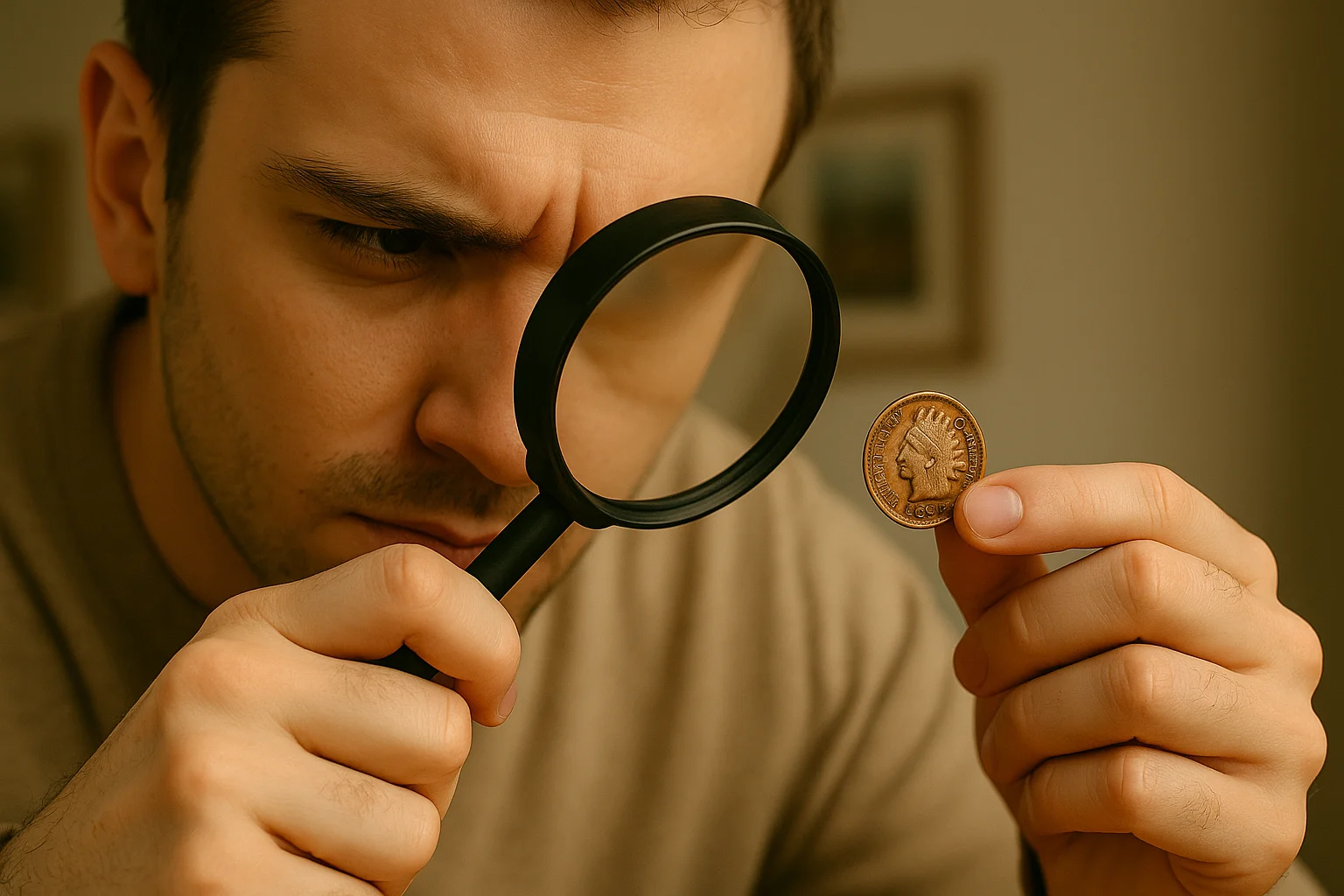A one-cent coin may seem insignificant, especially if it is sitting in a box of grandpa’s junk or in a forgotten wallet. But what if you have a truly valuable piece in front of you? This is the reason why questions regarding 1907 Indian Head penny value now are still relevant not only for collectors, but also for those who accidentally discovered an old copper coin and want to understand – keep it or spend it.
The Indian Head penny (actually, it is Liberty in a headdress) was minted in the United States from 1859 to 1909, and the 1907 issue is among the most common. However, even among the millions of these coins, there are specimens that are worth tens of dollars – it all depends on condition, rarity, and the presence of minting errors.
So, today we will learn together how to determine the authenticity and condition of your coin, what varieties there are, how much they can cost, and how to store them properly. And one simple tool will help you not to make a mistake in valuation – we will also mention below.

Quick Historical Background: Why the 1907 Issue Still Matters
When you hold a 1907 Indian Head penny in your hand, you are also holding a fragment of American history. This coin marked the final chapter of an era before the U.S. Mint transitioned to the Lincoln cent in 1909. That makes the 1907 issue more than just old – it is historically significant, as the coin bridges the gap between two of the most iconic coin designs in the country’s history.
Though it is not particularly rare in terms of mintage, the 1907 Indian Head cent for a long time was a favorite among both novice and experienced collectors. And that n isot by accident. The coin offers accessibility, charm, and the potential for surprising value (especially in well-preserved condition).
Here is why the 1907 issue still matters today:
- It was the second-to-last year of the Indian Head series, making it one of the last opportunities to own a classic 19th-century design.
- The U.S. Mint produced over 108 million coins that year, the highest mintage of any Indian Head cent.
- Every single coin was struck in Philadelphia, which means no mint mark appears. That alone helps with quick identification.
- Low-grade examples remain easy to find (making it a great entry point for new collectors).
- High-grade or error coins from this year can command hundreds or even thousands of dollars.
But here is the twist: despite the large mintage, very few coins have survived in excellent condition. The vast majority were worn down in circulation, and many were simply lost or destroyed over time. So, if you come across one with sharp details and minimal wear, you are looking at something increasingly rare – and increasingly valuable.
Spotting the Real Deal: How to Recognize an Authentic 1907 Cent
Before estimating value or getting your hopes up, the first step is to verify that your 1907 penny is genuine. And here we are speaking not just about weeding out fakes – it’s also about understanding the anatomy of the coin so you can properly evaluate its condition later.
Thus, we offer you to start with the basics:
Coin characteristics
| Feature | Details |
| Year | 1907 |
| Composition | 95% copper, 5% tin and zinc |
| Weight | 3.11 grams |
| Diameter | 19.05 mm |
| Edge | Plain (smooth) |
| Mint Mark | None (Philadelphia only) |
| Designer | James Barton Longacre |
| Obverse Design | Liberty wearing a Native American headdress |
| Reverse Design | Laurel wreath with “ONE CENT” and a small shield |
Once you’ve confirmed the basic specs, move on to the visual details. A genuine 1907 Indian Head penny should show clear artistry – despite its age. Focus on these key identifiers:
What to look for:
- The word “LIBERTY” must be visible across Liberty’s headband on the obverse. If the letters are faint or missing entirely, the coin is likely heavily circulated or worn down.
- The date “1907” should be cleanly struck and centered along the bottom edge.
- The reverse should show a laurel wreath tied at the bottom, with a small shield above the denomination “ONE CENT.”
- The rim should be even and raised, not soft or melted-looking.
Be cautious of coins that appear too shiny, unusually light, or rough around the edges. These may be cast counterfeits or heavily polished pieces with reduced collector value.
Collector еip: Use a magnifying glass or jeweler’s loupe to inspect the feather tips, ear curls, and the bow at the bottom of the wreath. The sharper the detail, the more desirable your coin may be.
From Pocket Change to Premium: Understanding Condition and Value
Once you’ve confirmed your 1907 Indian Head penny is real, the next big question is: what shape is it in? Because in the world of coin collecting, condition isn’t just a detail – it is often the difference between a 50-cent curiosity and a $500 showpiece.
How Coin Grading Works
Collectors and dealers use the Sheldon scale, which ranges from PO1 (Poor) – a coin barely identifiable – to MS70 (Mint State Perfect) – a flawless specimen with no visible wear even under magnification. Most coins fall somewhere in between.
For Indian Head cents, collectors break down quality by not just wear, but also color and surface shine. A worn coin might still have character, but a crisp, untouched one will always command a higher price.
There are three general color categories that affect price too:
- Brown (BN): the most common – and cheapest – because of oxidation
- Red-Brown (RB): some original mint luster remains
- Full Red (RD): rare and desirable – almost like the coin just left the press
Market Values for the 1907 Indian Head Penny
Here’s what collectors are paying in today’s market, depending on grade and color:
| Grade | Brown (BN) | Red-Brown (RB) | Full Red (RD) |
| G-4 | $1.25 | – | – |
| F-12 | $2.50 | – | – |
| XF-40 | $4.50 | – | – |
| AU-50 | $8.00 | – | – |
| MS-60 | $20.00 | $28.00 | $40.00 |
| MS-63 | $40.00 | $60.00 | $95.00 |
| MS-65 | $100.00 | $175.00 | $300.00+ |
Interesting fact: Coins graded MS66 RD have even fetched over $1,000 at auction. Those top-tier examples are extremely rare, often kept in professional collections or found only in sealed bank bags or old hoards.
But don’t be discouraged if your coin is not mint-state perfect. Even well-circulated coins hold value and can be part of a growing collection – especially when stored properly.
Lifehack for modern collectors: Not sure about the grade or authenticity or value of the cent (or any other specimen)? Coin ID Scanner helps instantly identify your 1907 penny (or another one), estimate its value, and detect known varieties – all through your phone’s camera. Just snap a photo, and the app does the rest.
For beginners, it’s like having a pocket-sized expert. For experienced collectors, it saves time and prevents costly mistakes. Whether you are sorting coins from an inheritance or combing through a flea market find, it is a tool worth using.
Discovering Errors and Rare Varieties in Your 1907 Penny
If there is one thing collectors love more than a well-preserved coin, it is a coin with a flaw – at least the right kind of flaw. Mint errors and rare varieties are some of the most exciting aspects of coin collecting, and yes, the 1907 Indian Head penny has its share of surprises.
While 1907 isn’t as error-heavy as some earlier dates, there are still a few standout varieties that can significantly increase value:
- Repunched Date (RPD): The most notable variety for 1907. In some coins, the date was punched into the die more than once, resulting in a visible doubling of the digits – especially the “9” and “7.”
- Off-center strikes: Caused when the planchet is misaligned during minting. Even slight off-centering can increase a coin’s worth, especially if the date is still visible.
- Die cracks and cuds: These small cracks or raised blobs occur when the die used to strike the coin begins to wear out or break.
Collector tip: Even a coin in lower condition (say, G-4 or VG-8) with one of these errors can be worth 10–20 times more than a standard example. Always inspect the date and edges carefully and don’t be afraid to seek a second opinion from a coin dealer or online forum.

How to Properly Store and Protect Your 1907 Indian Head Penny
Well, just imagine you’ve found a real 1907 penny. Maybe it’s not worth hundreds (yet), but it is clean, clear, and yours. Don’t toss it back in a drawer. Here is how to store and preserve it like a pro:
- Handle it with gloves. Your skin’s natural oils can leave permanent marks on copper.
- Gently place the coin in a soft, non-PVC holder—like a 2×2 cardboard flip or an airtight capsule.
- Label the holder with the coin’s year, potential grade, and where you found it.
- Keep it in a cool, dark place. Avoid exposure to direct sunlight or high humidity, both of which can cause discoloration or corrosion.
- Consider scanning and digitally archiving your coin (using tools like Coin ID Scanner earlier mentioned), so you have a record of its condition and value over time.
A Coin That Tells a Bigger Story
The 1907 Indian Head penny is more than just a collectible, it is a snapshot of a bygone era, struck into metal and passed from hand to hand across generations. Whether it is worth a few dollars or a few hundred, it is a tangible link to American history.
And if you take the time to learn its features, spot the details others might miss, and care for it properly, that little copper coin in your palm may end up being far more valuable – both financially and personally – than you ever expected.



